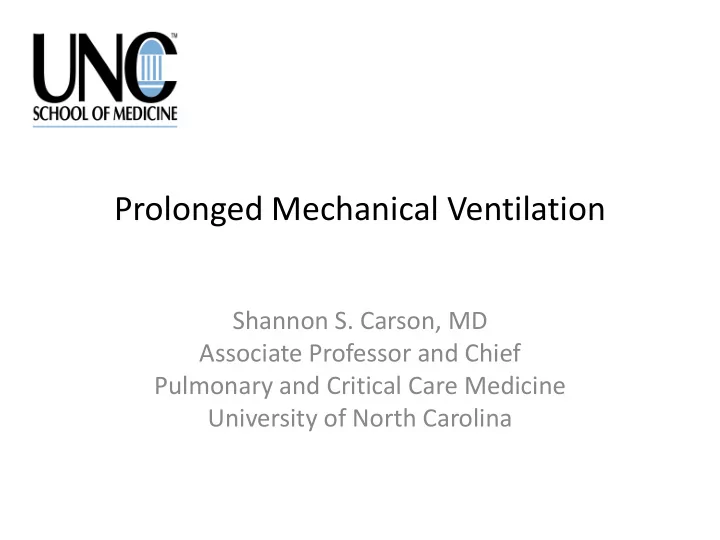

Prolonged Mechanical Ventilation Shannon S. Carson, MD Associate Professor and Chief Pulmonary and Critical Care Medicine University of North Carolina
AJRCCM 2010
Projected Growth of Prolonged Acute MV Zilberberg et al. Crit Care Med 2008;36:1451
Outcomes of Prolonged Ventilation Cohort Ventilation Ventilation for Tracheostomy for Weaning Definition for ≥14 days ≥21 days Prolonged Mechanical Center Ventilation Study Combes Carson Cox Engoren Rose N 347 200 114 267 347 115 Hospital 51 39 29 -- 28-37 64 (35-109) Length of Stay (36-72) (30-52) (22-38) median (IQR) Died in Hospital 43% 41% 31% 20% 22% 15% Discharged Home -- 11% 4% 7% -- 13% Alive at 12 months 32% 48% 42% 52% 50% 37%
Activities of Daily Living (ADL) scores 6 5 p = 0.04 between groups 4 p = 0.0001 for time trend 3 2 1 PMV non-PMV 0 -2 0 2 4 6 8 10 12 Follow-Up, Months Cox et al. Crit Care 2007.
Brain Dysfunction in PMV • Prospective cohort 203 patients from Respiratory Care Unit • Nelson et al. Arch Intern Med 2006;166:1993 – 82% cognitively intact at baseline – 30% comatose throughout RCU stay – 50% non-coma patients delirious • 6 month follow-up – 71% of survivors too cognitively impaired for tel. testing – Remaining 25% cognitively intact (30 patients)
Management Prevent Complications Maximize Function Communicate Prognosis/Goals of Care
Preventing Infections • Prevent Ventilator Associated Pneumonias – HOB elevation – Remove NG tubes – Avoid gastric distension – Chlorhexadine mouth rinses? – Avoid sedatives, narcotics when possible • Prevent Central Line Related Bloodstream Infections – D/C unnecessary lines!!! – Checklist – Full drapes – Line Cart
Infection Control in PMV • High threshold for broad spectrum antibiotics – Treat sepsis aggressively – Confirm infection before treating isolated fever • VAP – BAL/mini-BAL/Quantitative trach aspirate – Tracheobronchitis — be appropriately conservative • Bladder infections – SIRS and Pyuria – Positive culture with no other apparent source • Know local ‘Antibiograms’
Maximize Function
Nutrition • Avoid Overfeeding – Volume expansion, hyperglycemia, steatocholestasis, increased ventilatory load • McClave et al. J Parent Enteral Nutr. 1998;22:375 – 213 PMV patients from 32 hospitals – Indirect calorimetry measurements – 58.2% of patients receiving >110% of required calories – 12.2% were being underfed • 20-25 kcal/kg/day • Enteral and parenteral feeding? – Hollander, Mechanick. Nutr Clin Pract. Dec 2006;21(6):587
Pressure Ulcers • Prevention – Turning, Specialty Beds, Cleaning – Early Mobilization • Management – Debridement – Wet-to-dry dressings – Wound Vac? – Judicious use of antibiotics – Specialist Care
Mobility – Barriers or Excuses? – Limitations in cardiovascular and respiratory reserve – Bleeding risks – Cognitive function – Orthopedic issues, wounds – Attachments, Devices – Obesity • Solution: – Mobility Team • Morris et al. Crit Care Med 2006; 34:A20 – Adaptation of traditional roles • Physiotherapist model • Hopkins Crit Care Clinics 2007;23:81
Delirium Risk • Age • Baseline dementia • Underlying illness – Inflammation – Coagulation • Metabolic Disturbances • Hypoxemia, hypercarbia • Psychoactive Medications Inouye, JAMA 1996;275:852-57 • Sleep Deprivation Dubois, Intens Care Med 2001;27:1297-1304 Inouye, NEJM 1999;340:669-676 Jacobi, Crit Care Med 2002;30:119-141 Milbrandt, Crit Care Med. 2005;33:226-9
Psychological Support • Prevent delirium • Early mobility • Communication – Speaking valve • Oral feeding • Careful treatment of pain and anxiety • Depression – Extremely common • Jubran Intensive Care Med. May 2010;36(5):828 – Antidepressants work slowly – Methylphenidate • Woods et al. J Clin Psychol 1986; 47:12
Dedicated Units for PMV Patients • Multidisciplinary Rehabilitation Approach • Specialization within disciplines – RT, Nutrition, PT • Protocolized care • Lower nursing intensity; less monitoring – Lower costs?? • Short-term acute care hospital models • Long-term care hospital (LTCH) models
LTAC vs Acute Costs for PMV • LTCH patients and non-LTCH patients matched based upon propensity for LTCH referral • 68 days in episode with LTCH care vs 45.8 days without LTCH care • www.rti.org/reports/cms • Differences in episode payments and costs relative to non-LTCH patient with low likelihood of LTCH referral (lower left point on graphs)
Unroe et al. Ann Intern Med 2010; 153;167.
Unroe et al. Ann Intern Med 2010; 153;167
Age >65 - 2 points Platelets <150 - 1 point Day 21 of MV Age 50-65 - 1 point Vasopressors - 1 point Dialysis - 1 point Survival by ProVent Score 1.00 0.75 0.50 0.25 0.00 0 200 400 600 800 1000 Days Since Enrollment Score = 0 Score = 1 Score = 2 Score = 3 Score = 4 or 5 Area under ROC 0.79 (95% CI, 0.75, 0.81) Hosmer Lemeshow GoF p=0.89 Crit Care Med 2012; 40:1171-1176
Summary • Managing the complications of PMV should be considered within the context of improving functional outcomes as well as survival • Infections are the most common cause of death in PMV and are often preventable • Prolonged physical limitations should be prevented with early mobility, wound prevention, and nutrition • Care venues should be selected based upon patient needs, but are often determined by resources • Tools are available to improve understanding and communication of prognosis/goals of care
Survival of LTCH PMV Patients
Discordance Surrogates (%) Physicians (%) High Expectations For: One-year Survival 93 43 Functional Status 71 6 Quality of Life 83 4 Concordance: κ = 0.08 Cox Crit Care Med 2009;37:2891
Recommend
More recommend